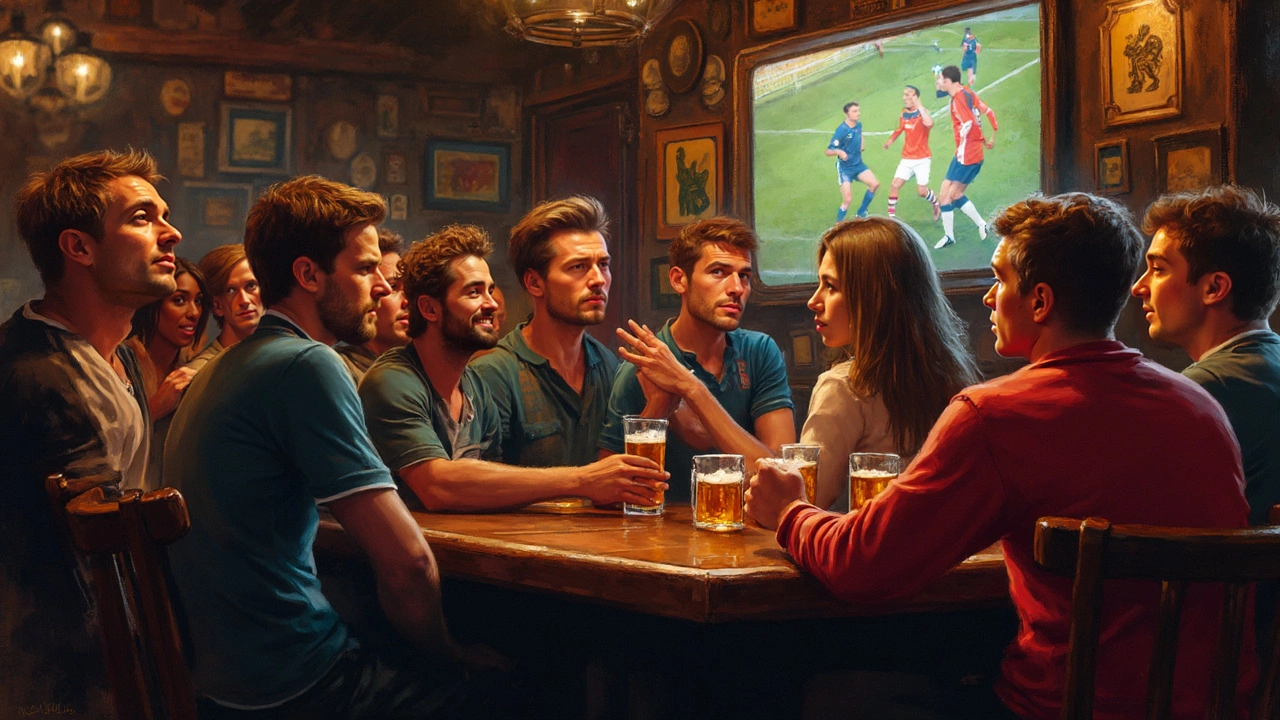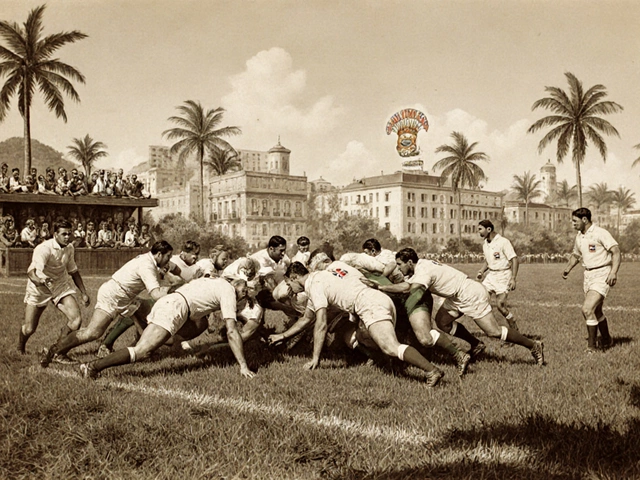
Football May 29, 2025
Football in One Word: What Defines Every Match?
Try to fit football into a single word? That’s wild, but if you’ve ever watched a packed stadium go nuts as a last-minute goal hits the back of the net, you get it. Football isn’t just a sport or some weekend plan. It’s raw, unpredictable, and always full of surprises—no matter if it’s a Champions League final or a local match at your neighborhood field.
Ever felt chills as players walk out on matchday and fans belt out their anthems? That’s the stuff you won’t forget. People don’t just watch for the scores—they show up for the drama, the comebacks, and those jaw-dropping moments when someone pulls off an insane move out of nowhere. Football grabs everyone’s attention because it always keeps you guessing. And honestly, isn’t that why most of us keep coming back?
- More Than Just a Game
- The Pulse of Matchday
- Players Make the Magic
- Moments You Can't Script
- Tips for Watching Like a Pro
- So, What’s the One Word?
More Than Just a Game
Football isn’t just about kicking a ball around—there’s a reason more people watch it than any other sport. Just look at the last FIFA World Cup: over 1.5 billion viewers tuned in for the final. That’s almost one in five people on Earth. It isn’t only about what happens on the pitch. It’s neighborhoods, rivalries, stories, and sometimes even bigger movements all tied to the game. When you hear someone call football a "religion" in places like Brazil or England, it isn’t a joke. Matches there can empty streets and bring cities to a standstill.
You’ll see huge cultural traditions built around football. Think of El Clásico in Spain—Real Madrid vs. Barcelona. It’s not just a match; it’s a clash of identity, history, and politics. In Africa, football stadiums become buzzing centers where people forget their daily grind for ninety minutes. And in places like Argentina, local derbies split families for a day or two. The football match is just the start. The actual passion and meaning carry through families, workplaces, and whole cities long afterward.
Here’s how those numbers stack up against other major events, just for context:
| Event | Estimated Global Viewers |
|---|---|
| FIFA World Cup Final (2022) | 1.5 billion |
| Super Bowl LVIII (2024) | 123 million |
| Olympic Opening Ceremony (Tokyo 2020) | 570 million |
That’s a huge gap. Football leaves every other event behind in terms of reach. So, if you’re looking at it like just a game, you’re missing the point. It drives economies, inspires art and music, and even makes politicians rethink their speeches when there’s a big match. The influence isn’t just on the screen—it’s a big deal in real life, too.
The Pulse of Matchday
Nothing compares to the buzz of matchday. It’s all about building up to kickoff—the chants, the rituals, and even the jitters in the air. Walk past any stadium an hour before game time, and you’ll see crowds in club colors, vendors selling scarves, and kids hoping for a selfie with their favorite player. Every football lover knows the vibe is totally different when you’re there in person.
Here’s a cool fact: the highest recorded attendance for a football match was back in 1950—about 199,854 fans packed Maracanã Stadium in Brazil for the World Cup final. Even today, big matches draw in crowds of over 90,000 at places like Wembley or Camp Nou. That’s a lot of energy packed into one place.
For TV viewers, the experience keeps getting sharper. Major leagues use over 30 cameras per match, giving fans every possible angle. Some stadiums even use drone and AI cameras to catch every move, so you don’t miss a thing.
Look at these key matchday stats from top European leagues last season:
| League | Average Attendance | Biggest Crowd |
|---|---|---|
| Premier League | 39,950 | 75,238 (Old Trafford) |
| Bundesliga | 43,016 | 81,365 (Signal Iduna Park) |
| La Liga | 28,769 | 99,354 (Camp Nou) |
Want to get the full matchday effect? Try arriving early. Soak up the *football* fever at fan zones where you can grab a snack, join in songs, or snap pics by team banners. Some stadiums offer stadium tours or interactive games for all ages before the main event.
- Arrive at least an hour ahead for pre-game highlights.
- Join fan chants—they really hype up the atmosphere.
- Scout out your seat early, especially if it’s your first time.
- Bring a portable charger (pictures eat battery fast!).
Whether you’re inside the stadium or watching with friends at home, this energy is what keeps folks coming back for more. It’s the pulse that makes every match feel massive, no matter who’s playing.
Players Make the Magic
It’s impossible to picture football without the larger-than-life characters on the pitch. Cristiano Ronaldo’s insane headers, Lionel Messi weaving through five defenders like they’re cones, or Virgil van Dijk shutting down entire attacks—this is where the magic lives. Every player brings their own style and skills, and sometimes that one wild move – a backheel pass or a last-ditch tackle – ends up in highlight reels for years.
The blend of talent, athleticism, and pure guts is what sets these players apart. Back in 2022, the Champions League final drew more than 700 million viewers, according to UEFA. That’s people tuning in from every part of the world, just to see the best do their thing under crazy pressure.
"Football is nothing without the fans, but it's also nothing without the players who make miracles out of nothing," — Arsène Wenger
Want to spot who’s likely to create game-changing moments? Here’s what to look for:
- Composure under pressure – Think of Luka Modrić controlling midfield in a packed stadium.
- Insane work rate – Like N’Golo Kanté running the whole field without slowing down.
- Creativity – When Kevin De Bruyne drops a no-look pass that splits defenders.
- Leadership – Sergio Ramos organizing, motivating, and even scoring crucial goals himself.
- Skill in crunch time – Ronaldo's overhead kick against Juventus in 2018 is still legendary.
For fans who dig into numbers, check this out—these are stats from top players in the 2022/23 season:
| Player | Goals | Assists | Successful Dribbles |
|---|---|---|---|
| Erling Haaland | 36 | 8 | 55 |
| Kylian Mbappé | 29 | 7 | 89 |
| Lionel Messi | 21 | 20 | 64 |
It all proves one thing: football matches change in a split second because players take risks and dare to try the impossible. That’s why people talk about these games for ages—the players make every minute matter.

Moments You Can't Script
Let’s be real—the best parts of football aren’t choreographed. They pop up out of nowhere and get replayed for years. Take Sergio Agüero’s goal in the dying seconds of the 2012 Premier League season. Manchester City went from heartbreak to champions in two minutes. You can’t plan moments like that. Or remember Brazil’s 7-1 loss to Germany in the 2014 World Cup semifinal? No expert or fan saw that coming. That’s what makes you keep your eyes glued to every match.
It’s not just the top leagues, either. Iceland’s journey to the Euro 2016 quarterfinals—beating England—was huge for a country with a population smaller than many towns. Those are the kinds of underdog stories people tell their kids about. Penalty shootouts packed with nerves, unexpected bicycle kicks, or goalies scoring during injury time—these are football’s magic ingredients.
Here’s something a bit surprising: according to Opta Stats, over 30% of goals in major football competitions come in the last 15 minutes of a match. That’s when everything is at stake and adrenaline takes over.
| Iconic Moment | Year | What Happened |
|---|---|---|
| Agüero's Title-Winning Goal | 2012 | Manchester City sealed the Premier League with a last-minute goal |
| Leicester City Title Win | 2016 | Leicester, at 5000-1 odds, won the Premier League |
| Germany Beats Brazil 7-1 | 2014 | Biggest shock in World Cup semis history |
| Iceland Beats England | 2016 | Iceland eliminates England in Euro 2016 |
If you want to soak up these moments, don’t change the channel or leave during the last few minutes. That’s when football gets wild, and history is made right in front of you.
Tips for Watching Like a Pro
If you want to level up your football watching game, skip the guesswork. There’s a reason regular fans and analysts catch things most people miss—it's all about knowing what to watch, where to look, and when to tune in. Check out these tips that will sharpen your experience, whether you’re on a couch or right there in the stands.
- Football is all about momentum shifts, so watch the midfield. Games are won and lost based on which team controls this space. If you spot a team bossing possession in the middle, odds are they’re about to create some magic up front.
- Keep an eye on key players, but don’t ignore the defenders or goalkeepers. Stats from FIFA show that the average defender makes around 40-50 passes in a game—more than most forwards. Big plays often start from the back.
- Don’t just follow the ball. Glance off-ball to see how players position themselves. Top pros read their teammates and rivals before the pass even comes. This is where you notice how teams set up pressing, counterattacks, or offside traps.
- Know the context. Whether it’s a Champions League knockout or a regular league game, the stakes change how teams approach a match. Finals and derbies almost always have higher pressing rates and more tackles, according to UEFA data.
- Listen to the crowd. When you hear an entire stadium roar or groan, it’s a clue something big just happened or is about to. Experienced fans use this as a cue to focus on replays or check what triggered the reaction.
If you really want to dig into the numbers while watching, here’s a quick look at what usually stands out in televised games:
| Stat | Average (per match) | Why It Matters |
|---|---|---|
| Passes Completed | 800-900 (total both teams) | Shows which team controls the pace of play. |
| Tackles | 30-40 | Tells you who’s defending with grit. |
| Goals | 2.5-3 | Gives you a sense if the game is defensive or wild. |
| Distance Covered | 105-110 km | Highlights intensity and work rate. |
Want to dig even deeper? Some fans keep a notepad or use apps like SofaScore or FotMob to track these stats in real-time. This helps spot patterns in games and makes every watch more fun—plus, your football chat just got a whole lot smarter.
So, What’s the One Word?
If you had to box all of football up into a single word, it’s “passion.” Seriously, nothing else fits the chaos and electricity you get from players, coaches, and fans every single match. When you watch a crowd go nuts after a winning goal, or see players collapse on the grass because they’ve given everything, it’s all about passion—pure and simple.
Let’s look at how deep this goes. Did you know the 2022 FIFA World Cup final racked up over 1.5 billion viewers worldwide? That’s more than any Super Bowl or Olympics moment. People from every corner stop what they’re doing just to watch the game. Countries shut down. Workers sneak a peek at their phones. Even folks not big on football join the excitement because it’s contagious.
| Moment | Year | Estimated Global Viewers |
|---|---|---|
| 2022 World Cup Final | 2022 | 1.5 billion |
| 2018 Champions League Final | 2018 | 380 million |
| Euro 2020 Final | 2021 | 328 million |
But it’s not just about the numbers. Grassroots football is just as wild. Go anywhere—Brazilian beaches, English village greens, dusty African fields—people are playing, laughing, fighting, and celebrating. It’s one of the few things that can pull kids and grandparents together like nothing else.
If you want to feel the pulse of the game, try this next time you watch:
- Pick up on chants and songs in the stadium—they’re often unique to each club or country and tell you a ton about the culture and pride behind each group of fans.
- Pay attention to celebrations—players and fans go big because every goal feels like a once-in-a-lifetime moment.
- Notice the reactions after a loss; tears and heartbreak aren’t rare, and it shows just how deep the connection runs.
So yeah, if you ever get asked, “What’s football in one word?”, you’ve got your answer. And honestly, once you see it in action, there’s no way to un-see it.




